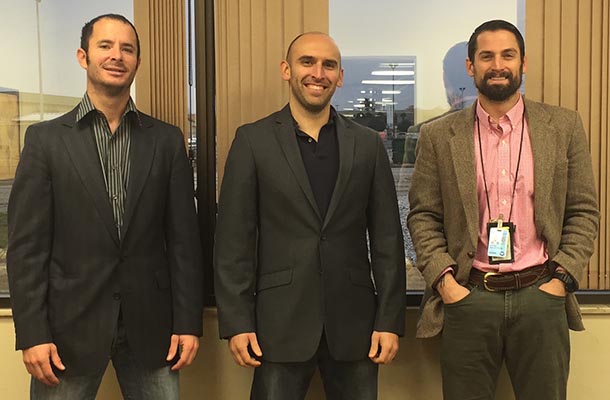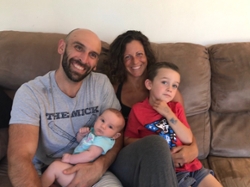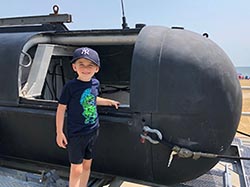
Ken Corl (middle), enjoys working closely with his peers. He explained that the breadth of the projects allow them to grow as professionals because they learn about almost all of the engineering domains. IMAGE: KEN CORL
Engineering alumnus leverages his master's for government innovation
7/28/2020
By Miranda Buckheit
UNIVERSITY PARK, Pa. — Ken (Kenny) Corl, a former Navy SEAL, was thrilled when his government contracting company positioned him as the point human factors engineer on a new project.
The only hiccup: his background was in electrical engineering, not human factors.
To step up to the plate, he chose to get his online certificate in human factors engineering and ergonomics from the Penn State Harold and Inge Marcus Department of Industrial and Manufacturing Engineering. He explained that he chose the department because of the College of Engineering’s reputation as being a top engineering school.
Upon completing the certificate program in 2014, he began shopping around for a master’s program. He decided that sticking with the top-ranked department was the best option.
Corl hit a road block upon his decision, as he was living in Huntsville, Alabama, at a time before the department began offering an online master of engineering in industrial engineering.
To earn his degree, Corl devised a plan to take specific online courses to satisfy the requirements. Through bumpy roads and many flights, Corl graduated with his master’s degree in 2016 along with another certificate, this time in applied statistics.
“I started adding it up and realized that I could do most of the degree at a distance because most courses had an online option,” Corl said. “I worked closely with the department to make this work because there were still a few classes that weren’t offered online. The department was incredibly accommodating and I’m glad that they have an online degree now.”
Corl, still with the same contracting company, uses the information he gained during his experience with the department to continue to modernize the design of government underwater vehicles.
Designing an underwater vehicle’s dashboard
While the journey was not smooth, Corl managed to visit campus eight times during his master’s degree for the industrial engineering colloquium, called IE 590, which is a mandatory class for all graduate students.
Corl had the flexibility of being located in Virginia for a project that lasted a few months during his degree. This placement allowed him to drive to campus once a week for the colloquiums. When he was placed in Alabama, he would fly.
“In total, I only missed two of the colloquiums,” Corl said.
During his time with the department, Corl completed a research project in place of a traditional thesis. Specifically, Corl focused on the cockpit design of submersibles.
Submersibles, similar to submarines, are unique: they fill with water as the person inside breathes oxygen from a tank connected to the vehicle. When the person inside seeks to exit for exploration, they hook up to a portable oxygen tank.
This method allows for ease of access and simplicity in design. Often, the creation of conventional submarines is tricky: engineers have to craft the vehicle’s chambers carefully to keep the water out and to prevent the hull from cracking.
Corl wanted to learn the best way to lay out a cockpit display, as the drivers of the submersibles are wearing gear that keeps them safe within the water’s varying temperatures. To do so, Corl worked closely with Andris Freivalds, Lucas Professor of Industrial Engineering.
“You’re basically in scuba diving gear and you could be in warm tropical waters or you can be in cold Arctic waters,” Corl said. “Cold waters dictate that you might need a heavy glove. And if you have thick, heavy gloves, you’re going to need bigger display buttons that are spaced farther apart. If you put on snow gloves and then try to type on a keyboard, you’re going to mistype all over the place. Also, the buttons will be big, so you have to account for the fact that you’re going to have a limited amount because of their size.”
Corl notes that while his organization isn’t using his exact design, he enjoyed the experience of getting to put all of his ideas down on paper. Corl explained that in his industry, the engineers often get handed requirements, but they still try to find ways to make improvements.
“I thought, ‘Well, if I have to design this in the best way I know how, what will it look like?’” Corl said. “I enjoyed the project because it made me think critically. I really want to give thanks to Dr. Freivalds, Dr. Chandra and my off-campus proctor, Scott Silvey, who is a software engineering manager.”
An umbrella
Corl has worked with his company for 11 years. He notes that the organization has allowed him to work within a variety of engineering areas due to the great breadth of project needs. He explained that his master of engineering degree helped him be more prepared.
“The degree allowed me to diversify my engineering experience more confidently,” Corl said.
Corl explains his role more as an umbrella because he covers a wide domain, but he largely serves as a systems engineer. He explained that the projects move through phases that cover a span of engineering disciplines. The nature of this pattern allows him to work beyond his primary capacity to learn more aspects of the business.
Corl advises students who are looking at a graduate program that is resident based or online to learn how to prioritize life in the “right way.”
“I wouldn’t prioritize what you need to get done all the same,” Corl said. “A lot of people get consumed with work and you see people breaking their backs. You need to make sure what you’re doing is a fair balance with what makes you happy.”
Corl lives with his wife, Lauren, their son, Mickey, and their daughter, Mattie. In his spare time, Corl serves in the Navy Reserves, giving him an impressive total of 16 years of military service.
The student spotlight series by the Penn State Harold and Inge Marcus Department of Industrial and Manufacturing Engineering (IME) aims to highlight innovators, makers and those who personify engineering excellence in their academic studies. The department currently has 90 doctoral students, 59 master’s students and 436 undergraduate students. In addition, the department hosts 42 full-time and courtesy faculty members. Established in 1908, the department is home to the first industrial engineering program in the world and has made a name for itself in the engineering industry through its storied tradition of unparalleled excellence and innovation in research, education and outreach. To learn more about IME and how you can get involved, visit ime.psu.edu.





